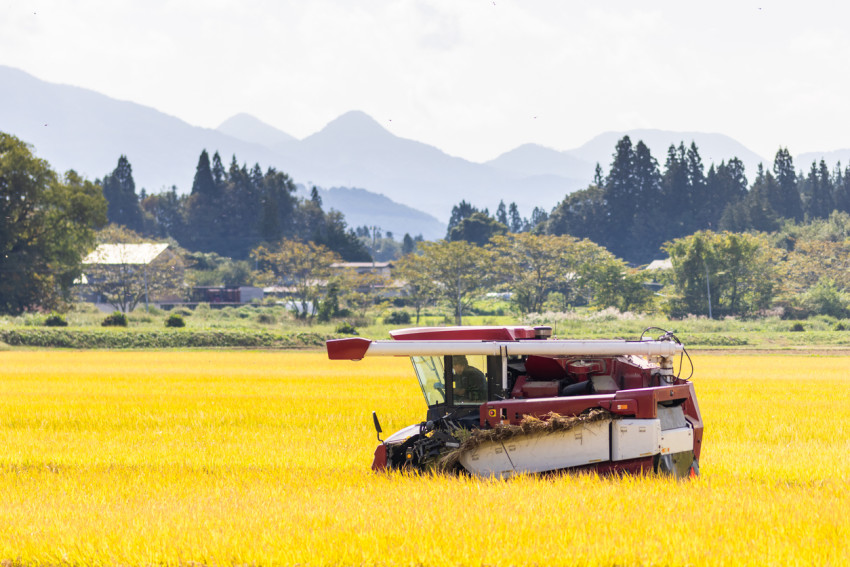The Japanese government plans to increase the country's rice exports by nearly eight-fold to 350,000 tons, worth 92.2 billion yen, in 2030 from 2024, according to a policy presented to a ruling party meeting Wednesday.
The plan to boost exports through improved production is also seen as a way to secure sufficient domestic supply of the Japanese staple to avoid shortages.
In its draft for a medium- to long-term basic plan for agriculture, the government kept intact its goal of raising the country's food self-sufficiency rate to 45 percent on a caloric intake basis by 2030 from 38 percent in fiscal 2022.
The figure refers to the ratio of domestically consumed food supplied by producers in the country.
The draft of the basic plan, revised roughly every five years, highlighted the need to enhance productivity in addition to expanding exports, noting that geopolitical risks and a decline in domestic farmers have destabilized food production and supply in the country.
The government aims to increase the total value of agricultural and food exports from 1.5 trillion yen in 2024 to 5 trillion yen in 2030, while boosting food-related spending by inbound tourists from 1.6 trillion yen to 4.5 trillion yen.
For rice production, the plan presented to the Liberal Democratic Party gathering aims to increase the number of farmers managing fields of 15 hectares or larger and reduce production costs from 11,350 yen to 9,500 yen per 60 kilograms to compete with cheaper imports.
Japan consumes approximately 6.6 million tons of rice a year, meaning the 350,000-ton export target would be equivalent to around half a month's domestic consumption.
While there is currently a domestic rice shortage, long-term demand is expected to decline due to Japan's shrinking population, making expanding exports a key focus.
Previous basic plans have used the food self-sufficiency rate as a key numerical target, but the latest one will feature several goals following the amendment to a related law last May. The government will seek Cabinet approval by the end of the month.
© KYODO














29 Comments
Login to comment
cartier
Typical. Japan believes it should be allowed to expand rice exports 8x but ban the import of foreign rice.
BertieWooster
Only 38% of food consumed in Japan is produced domestically! That is a very dangerous situation.
proxy
Great to see the government focus on the problem of low productivity in agriculture.
The_Beagle
If there is such an abundance, the domestic price should be far more reasonable. Why are they squeezing their own people this way?
Geeter Mckluskie
There's not "an abundance"...there is a "plan" to increase production
wallace
Production can only be increased if there are more farmers growing rice. Change to high yield varieties.
factchecker
Who abroad is buying it? The ex pats and the Japan obsessed abroad would be it. Meanwhile Taro's who live here end up paying double.
rainyday
At the current rate, a single 10kg bag of rice at the grocery store will probably cost that much by then.
Aly Rustom
Exactly.
maxjapank
Shall we purchase a rice field in our old age? We can meet up for a canned coffee at our shared vending machine between our two rice fields.
wallace
"Rice was the 447th most exported product in Japan. The main destinations of Rice exports from Japan are: Hong Kong ($18.5M), United States ($14.4M), Sao Tome and Principe ($9.88M), Singapore ($8.92M), and Chinese Taipei ($6.35M)."
WoodyLee
Very Good, Japanese rice is amongst the best in the world.
Good Luck
Jordi Puentealto
Bureaucracy just crunching numbers. Solve the domestic situation first. And export only the real surplus and let in varieties from abroad.
deanzaZZR
Triple the amount of exports in 5 years? Be Ambitious Boys.
gsa
Each rice is best for that regional cuisine.
Due to stickiness, Japanese rice is not the most suitable rice variety for most dishes beyond East Asia.
For example: if you are making risotto, pilaf or paella then Carnaroli, Arborio or Baldo are better options.
Also, for god sake, just produce enough rice to feed Japanese first so we don't have to keep hearing silly statements like "Foreign tourists eating all the rice in Japan".
Kumagaijin
Population is shrinking and the land available to farm should also be increasing in theory, but yet I see rice fields being turned into housing around Kanto. I also don't see a new generation of rice farmers. I'm really curious how the J-Gov is going to promote rice farming as a career/hobby and stop agricultural land from being developed.
One possible solution of course is to bring in immigrants, which is how Canada was able to grow and develop its agriculture. The difference however is that in Canada, land was seen as an investment, while in Japan, owning agricultural land isn't a great investment. Its also much more difficult to just buy a farm/land in Japan right after you get off the plane.
TokyoLiving
Go Japan..
You can do it..
TokyoLiving
100% true..
Like it or not..
リッチ
Exports when you don’t have enough to bring down the cost of rice in Japan to the same price as neighboring countries. These people are just stupid.
GuruMick
I get really excited when people talk about rice.
Droll Quarry
Japan imports about 350,000 tons of rice from the US, tariff free, anything above that is tariffed at 400%. They did this in response to a World Trade Org. agreement in the early '90s. This is about a half months domestic consumption. Something seems off in the current rice shortage. So who is pocketing the profit?
Droll Quarry
Simply shift the domestic rice to human consumption and the imported rice to Moo the cow and Cluck the chicken, they won't notice and everyone will be happy except the grifters.
HopeSpringsEternal
Not to the US with 700% tariffs on domestic rice imports.
April 2nd Japan's US rice tariffs will be 700% = reciprocal
Hello Kitty 321
If Japan hadn’t exported 45,000 tons of rice in 2024 then perhaps there would not be a shortage this year. I do not see how increasing exports helps shortages at home.
grund
Yields could always be improved by switching to more high yielding rice varieties, and as the article says, by increasing the size of the farms. But with the average age of Japanese farmers being something like 70 years old it doesn't seem realistic.
OkinawaRider
maxjapankToday 08:07 am JST
Shall we purchase a rice field in our old age? We can meet up for a canned coffee at our shared vending machine between our two rice fields.
Good one.
maxjapank
Speaking of suitable rice for dishes. When I first came to Japan, I invited some friends over for dinner. I was only going to make Chahan (fried rice), but I still thought that the more expensive the rice, the better it would be. So I bought a small bag of the most expensive stuff in the store. I couldn't figure out why my Chahan became so sticky until my girlfriend noticed I had purchase Mochi-gome.
Speed
They should cut down on exports if there's a shortage here at home like they claim. The prices domestically are way too high.
ian
There